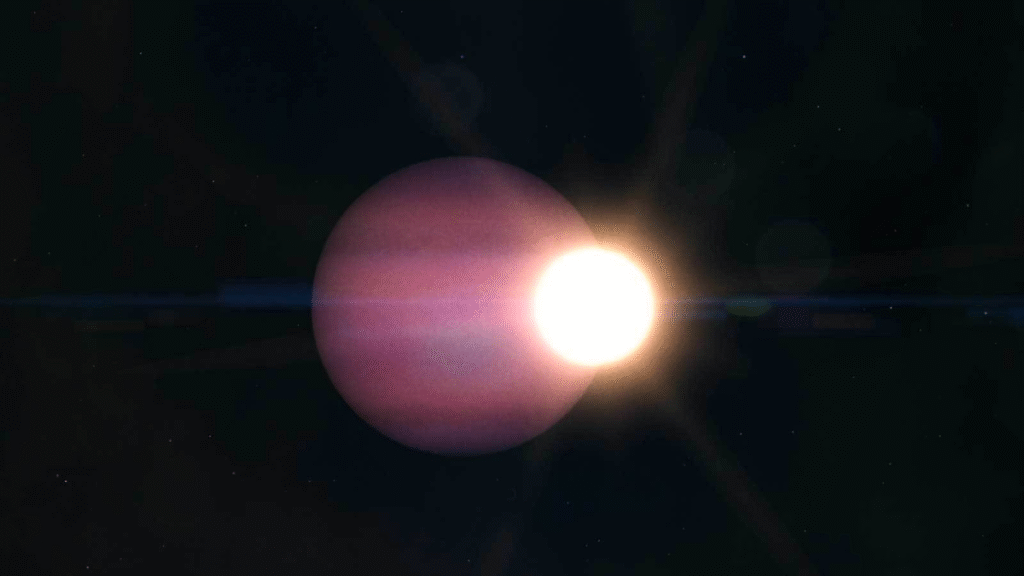A Historic Discovery by the James Webb Telescope
The James Webb Space Telescope (JWST) has made a groundbreaking discovery, confirming the coldest exoplanet ever observed—WD 1856+534 b—on May 5, 2025. Located 81 light-years from Earth, this Jupiter-sized gas giant orbits a white dwarf star, the remnant of a once Sun-like star, every 1.4 days. With an average temperature of 186 K (-87°C or -125°F), WD 1856+534 b shatters previous records, surpassing the prior coldest exoplanet, Epsilon Indi Ab, which had a temperature of 2°C. Led by Mary Anne Limbach from the University of Michigan, the international team used JWST’s Mid-Infrared Instrument (MIRI) to directly detect the planet’s thermal emissions, a feat that highlights the telescope’s unparalleled infrared sensitivity.
First spotted in 2020, WD 1856+534 b initially puzzled astronomers, who debated whether it was a planet or a brown dwarf—a “failed star”—due to limited temperature data from the retired Spitzer Space Telescope. JWST’s advanced capabilities resolved this uncertainty, confirming the object as a planet with a mass six times that of Jupiter, far below the 13.8 Jupiter masses previously estimated. This discovery not only sets a new benchmark for exoplanet research but also challenges our understanding of planetary survival in extreme cosmic environments.

Surviving the Forbidden Zone: A Cosmic Anomaly
What makes WD 1856+534 b, the coldest exoplanet, truly remarkable is its orbit within the “forbidden zone” of its white dwarf star. During a star’s red giant phase, it expands massively before collapsing into a dense, Earth-sized white dwarf, typically destroying or ejecting any nearby planets. Yet, WD 1856+534 b orbits just 0.02 astronomical units from its star—closer than Mercury is to our Sun—raising questions about how it survived. Limbach noted in a statement that this survival offers “compelling evidence that planets can endure the violent death of their star and migrate into orbits we didn’t expect.” This migration likely occurred after the star’s collapse, possibly due to gravitational interactions with other undetected planets in the system.
The planet’s frigid temperature, despite its close orbit, results from the white dwarf’s dimness. Unlike a main-sequence star, a white dwarf emits minimal heat, leaving WD 1856+534 b in a deep freeze. Its temperature is only 100°C warmer than gas giants like Jupiter in our Solar System, making it a rare analog for studying cold planetary atmospheres. The discovery opens a window into planetary evolution, showing that even in the aftermath of a star’s death, planets can persist in unexpected ways, challenging the narrative that such environments are inhospitable.
Implications for Science and Future Exploration
The confirmation of WD 1856+534 b as the coldest exoplanet has far-reaching implications. Its proximity to the white dwarf’s habitable zone—where liquid water could theoretically exist—makes it a unique case study, though its gas giant nature rules out habitability. The JWST team plans further observations in 2025, including data from the Near-Infrared Spectrometer (NIRSpec), to analyze the planet’s atmosphere. Preliminary findings suggest a hydrogen-rich composition, potentially with methane and carbon dioxide, offering insights into the chemistry of cold gas giants. These studies could reveal how planets form, migrate, and survive in extreme conditions, reshaping our understanding of planetary systems beyond our Solar System.
This discovery also underscores JWST’s role in exoplanet research. Unlike traditional methods that infer planets from stellar wobbles or dimming, JWST’s direct imaging captures the planet’s own light, a technique ideal for faint, cold worlds. Posts on X reflect excitement, with users noting, “JWST is rewriting what we know about exoplanets!” However, some skepticism exists, with a few questioning whether undetected companions might have influenced the planet’s orbit, a theory the team aims to explore with future observations. This finding challenges the establishment’s focus on hotter, younger exoplanets, proving that colder worlds around stellar remnants deserve equal attention.
A New Frontier in Cosmic Exploration
The discovery of WD 1856+534 b as the coldest exoplanet marks a triumph for JWST and opens new frontiers in astronomy. It demonstrates that planets can endure the most violent stellar transformations, offering a glimpse into the future of our own Solar System when the Sun becomes a white dwarf in billions of years. While WD 1856+534 b isn’t a candidate for life—its temperature is far below the 5°F threshold where life can grow—it provides a laboratory for studying planetary resilience and atmospheric dynamics in extreme conditions.
As JWST continues its mission, astronomers hope to find more cold exoplanets, potentially uncovering trends in their formation and survival. NASA’s upcoming Habitable Worlds Observatory, set for launch in May 2027, will build on this work, targeting Earth-like planets around Sun-like stars. For now, WD 1856+534 b stands as a testament to the universe’s complexity, showing that even in the darkest, coldest corners, there are worlds waiting to be explored.
